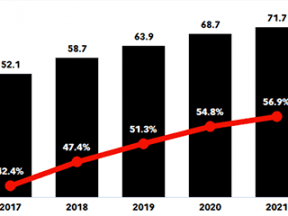Ecommerce marketers use many tactics to attract new customers, including pay-per-click advertising, search engine optimization, content marketing, and display advertising. But how does an ecommerce company decide which of these marketing tactics work the best?
Customer acquisition cost helps to answer this question. CAC is a key performance indicator for ecommerce marketing. It estimates how much to invest to attract one new customer. One could say CAC seeks to describe marketing efficiency.
CAC Calculation
Calculating CAC is simply a matter of division. An ecommerce business would take its total promotional costs for a given period and divide those costs by the number of new customers.
Promotional costs ÷ Number of new customers = CAC
The result is CAC. It should be compared to the business’s average estimated customer lifetime value or its average order value. Which comparison an online merchant uses may depend on the company’s business model or how long it has been operating.
Here is an example. Imagine an online store has been operating for three months. During these three months, the business invested $10,000 in marketing and acquired 2,351 new customers.
10,000 ÷ 2,351 = 4.25
The company’s CAC is $4.25. In this case, the new merchant may not have enough information to project an estimated lifetime value for each customer. But the merchant does know its average order value was $76 and its average cost of goods sold was $42. Thus, the company has a gross margin of $34 per order. Spending $4.25 in advertising to get $34 in gross margin would be a good marketing investment.
Channels, Tactics
CAC is often most informative when it is used with other KPIs to compare marketing channels, campaigns, or tactics.
Here is an example that compares tactics for a brick-and-click retailer. In this made-up scenario, the company has four significant advertising initiatives: (i) a circular that is distributed via newspaper to 250,000 homes, (ii) a Valpak direct-mail campaign to 100,000 recipients, (iii) a Google PPC campaign, and (iv) a YouTube campaign.
Based on the hypothetical values below for a month’s worth of overhead, labor, and advertising cost (which includes production and printing), should the company reconsider its advertising? Probably so. The company spent $48,775 for a newspaper circular that generated just 125 new customers.
| Circular | Valpak | Google PPC | YouTube | |
|---|---|---|---|---|
| Overhead | $2,500 | $250 | $500 | $1,750 |
| Labor | $6,275 | $800 | $250 | $2,500 |
| Total Ad Cost | $40,000 | $3,999 | $10,000 | $10,000 |
| Total Marketing Cost | $48,775 | $5,049 | $10,750 | $14,250 |
| New Customers | 125 | 2,950 | 1,935 | 3,400 |
| Customer Acquisition Cost | $390.20 | $1.71 | $5.56 | $4.19 |
| Average Order Value | $55.00 | $98.00 | $76.00 | $78.00 |
| Cost of Goods Sold | $33.00 | $58.80 | $45.60 | $46.80 |
| Gross Margin | $22.00 | $39.20 | $30.40 | $31.20 |
| Profit after CAC | -$368.20 | $37.49 | $24.84 | $27.01 |
Marketing Costs
CAC, however, can easily be underestimated. Often ecommerce businesses will overlook expenses directly related to attracting new customers, such as:
- The cost of placing ads.
- Ad production costs.
- Labor for ad design and copywriting.
- License fees for graphic design software.
- Wages to place and manage ads.
- Subscription fees for marketing software to plan, test, or place ads.
- Salaries associated with marketing strategy and management.
- Associated customer service expenses.
In short, an ecommerce business may want to include any customer-acquisition-related expenses, wages, and overhead in a CAC calculation.
Including these items, however, can be challenging, particularly when you want to compare specific ecommerce marketing tactics.
Estimating Labor
Now, look back at the example campaigns above. Notice the example divides labor and overhead by campaign. This is important for specific campaigns or tactics.
There are a few ways a business can estimate labor costs by channel. For example, to estimate the wages and salaries associated with each campaign, a business could implement time tracking. Using some form of time tracking software, ask relevant personnel to track their time for one month.
When a graphic designer works on a direct mail design, she tracks it. When a writer polishes a pay-per-click headline, he tracks it. At the end of a month, the business will have enough data to assign an average value to a task. It could determine, for example, that writing a PPC ad takes about 15 minutes. Thus if a campaign required eight ads, it would cost about two hours in labor.
Estimating Overhead
Expenses such as rent and utilities can also be estimated for CAC calculations. Here is an example.
Imagine there is an ecommerce business with four employees. The business rents an office for $1,450 per month. Assuming each of the employees has equal square footage, the rent is $362.50 per employee. If a typical employee works 172 hours per month, his or her share of the rent is $2.11 per hour. A task that takes 15 minutes — such as writing copy for a PPC ad — should include 53 cents in rent for CAC purposes.
Similar calculations can be done for utilities, coffee service, equipment, and similar if a business chooses to associate these with CAC.
Trouble Spots
Like so many KPIs, CAC can be misinterpreted. For this reason, it is important to consider CAC in context. If, for example, a business is considering CAC for May, it needs to ensure that the impact of a campaign is felt in that month. Some forms of marketing make take more than a month to develop a sale.




